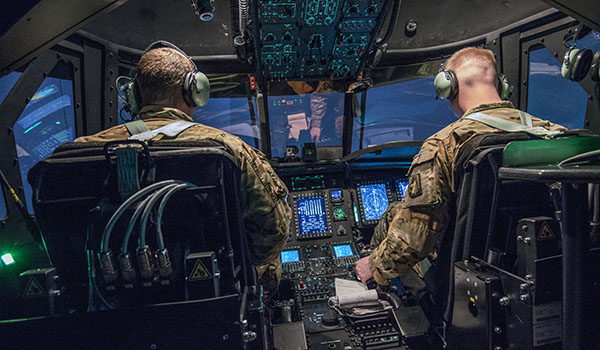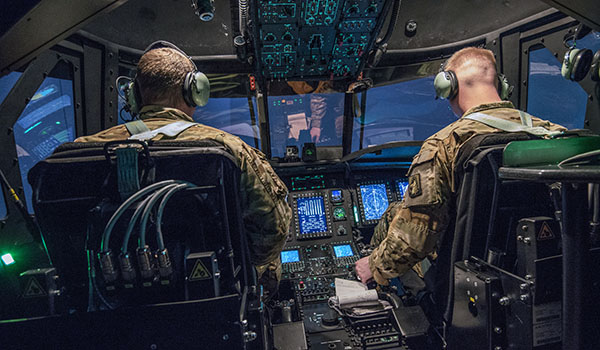
CWOB / By CW5 Jonathon P. Koziol: First, I am honored to be selected as the next Command Chief Warrant Officer of the Branch. I understand the importance of the position and my responsibilities to represent our aviation warrant officers, but more importantly, the aviation branch.

Army Aviators assigned to B/1-214th Aviation conduct annual CH-47 Flight Simulator training at the flight simulator in Illesheim, Germany./ U.S. ARMY PHOTO BY GEORGIOS MOUMOULIDIS
I will continue to work hard on initiatives that will better manage and benefit our aviation warrant officers. I will embrace the opportunity I have been given and work hard for our aviation warfighters. There are multiple efforts moving forward and I am excited to move them over the goal line.
At my previous position at the Pentagon, I witnessed the day-to-day hard work our Aviation Enterprise is doing in modernization, policies and doctrine that will continue to improve on an already lethal aviation warfighting force.
Of course, this all starts right here at Fort Rucker with our flight training program. To ensure we continue to produce the best aviation Soldiers in the world, the Branch must be funded to 100% of our training requirements. In the past several years, due to budget constraints, we have not always produced the number of aviators required annually; the bottom line is cost. We must continue to find solutions to produce a better aviator at the best value and advancements in simulation is one of many solutions.
Tech Innovations
We are on the brink of technical innovations that will reshape the way we train our future warfighting forces. Advancements in virtual reality (VR), artificial intelligence (AI) and advanced biometrics will aid us in training Soldiers more efficiently, which will optimize production at the schoolhouse.
As with anything in life, “practice makes perfect.” In whatever profession we work in, frequency and repetition at tasks make you better. Unfortunately for our aviators, especially flight students, the ability to just jump into a simulator or actual aircraft to practice is not always practical. Army aviation training is expensive. Especially, if we have to focus training in actual aircraft. Even though simulation devices are limited in number due to the cost being in the upwards of millions of dollars, they give us the ability to offset costs of maintaining proficiency in our fighting force.
Now, imagine there are companies out there who could produce new VR training devices and significantly drive down costs. Add in AI, who will be the virtual instructor capable of instructing a student with immediate feedback. Biometrics can tell if the aviation student is looking at the proper instruments or manipulating the controls properly and measuring the cognitive load of the student. Understanding when the student is task saturated or if it appears the procedures are too easy. The ability to adjust training immediately for the individual will allow us to harness proficiency-based training to standard instead of time.
Venues
As the technology improves and drives down costs, it will give us the ability to have greater access to training devices in the classroom, at work, and possibly at home. Classroom trainers for each student and multiple training devices at places like the technical library will allow the students to practice and hone their skills. It was not too long ago it was a huge step to transition to a fully digital classroom and issue computers to each flight student. Looking forward, one day we can issue VR devices that are part of the flight students training aides. The frequency and repetition afforded our students combined with the immediate instruction will allow us to gain efficiencies at the beginning of flight school and possibly with other aviation courses. This innovative training will allow us to reinvest training dollars into our advanced aircraft training and tactics.
With that being said, there is no replacement for the real thing. What VR and AI can do is allow us to optimize the training dollars while still producing a better Warfighter.
Change is coming. Let us all embrace this change and help to work towards the future. Think outside the box and not in the aspect of “that’s how we have always done it” mentality. What I ask of you, the Warfighter, is this: Although the technical advancements we are working on here in flight school and what you work with in your aircraft are leading edge, we must remember the basics. Simple things such as reading a map and terrain recognition are the building blocks for the tactics we will use to counter our adversaries. Take advantage of the Aviation Warfighting Initiatives and exportable training packets that have been produced. Never quit on bettering yourself.
I look forward to working with all of you to better our Branch.
Above the Best!
CW5 Jonathan P. Koziol is the chief warrant officer of the Aviation Branch with the U.S. Army Aviation Center of Excellence, Fort Rucker, AL.










